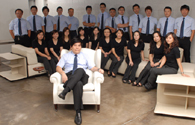3. Commercial practices and social marketing that highlights social responsibility
Enterprises take and implement voluntary commercial practices, make investments, or plan and implement activities to improve public health, safety, community welfare and the environment.
Case: China Minsheng Banking Corp’s investment in a nonprofit art gallery
CMBC, through continuous financial support, took over the Yanhuang Art Museum, which was on the verge of bankruptcy, and planned to transform it into a first-class nonprofit museum. CMBC is also planning to set up the Minsheng Modern Art Museum and is considering establishing an Asia Arts Forum to set up a fund for outstanding Chinese artists. By supporting welfare and nonprofit arts, CMBC has achieved positive effects in building a brand image as a bank with a high sense of responsibility for the arts.
4.Enterprise charity activities
Enterprise charity activities occur when an enterprise directly supports a particular charity organization or a public welfare undertaking, most commonly providing cash donations or non-cash services.
Case: Charity donations by China National Offshore Oil Corp
On the fifth anniversary of its listing on the Hong Kong Stock Exchange, CNOOC donated 8 million yuan ($1.27 million) to Project Hope to construct CNOOC CDSL Hope Primary Schools in Yunnan and Hainan provinces. CNOOC, through charity projects, such as “mother water cellars” and “health express”, and cash and materials donations for poverty alleviation and disaster relief, built up its corporate image among the public in the past decades.
III. Utilize public relations and branding activities that highlight social responsibility
Public relations could be the most effective method to establish and develop a brand. It is crucial to choose and apply appropriate PR strategies. There are three strategies to plan social responsibility activities for brands:
1. Build a relationship between PR activities and establish social value or hot issues
This strategy can not only help brands quickly become a source of information for public media, but can also generate positive effects for PR activities. For the majority of Chinese consumers, disaster relief, environmental protection and patriotism are important issues. In case of emergencies and incidents, PR activities could be appropriately used to convey an enterprise or brand’s social responsibility. The result would leave a lasting impression on consumers.
Case: During the SARS outbreak in 2003, Buick invited famous pianists from Europe to perform at a concert, Love for the Classics in May, hoping that music could comfort the hearts of Chinese who were dealing with the difficult time(2).
Case: Kodak once invested more than 2 million yuan ($318,000) to renovate and redesign the three scenic areas of Zhangjiajie, including the replacement and improvement of 300 directory and information plates for roads, scenic areas, environmental protection areas and precious plants. All plates were made of natural materials and blended well with the environment, highlighting Kodak’s environmental protection awareness. In executing this charity activity, Kodak helped consumers better understand and recognize the Kodak brand.
Case: The Body Shop opposes the use of animals for experiments. It advocates helping developing-nation economies through “trade, not assistance” in order to protect rainforests. The company also takes part in activities to save whales, publicizes the protection of other endangered species, and supports the development of alternative energy. In the area between products and test samples, the company places various posters and brochures focusing on its products, its support for charity activities, and information about how consumers can engage in charity activities and join charity organizations. Through publicizing its views on environmental protection, the protection of aboriginals and its opposition to use of animals for experiments, the Body Shop has received valuable coverage by newspapers, magazines, TV stations and radio stations, helping its brand grow and gain attention.
2. Planning social responsibility activities which engage customers
When a social responsibility activity involving brands is planned, consumers should be given the chance to directly participate. This will play a driving role in improving the social responsibility of the brand.
Case: On World Environment Day in June 2006, Nongfu Spring held a press conference at the former residence of Soong Ching Ling in Beijing. At the same time, the company officially launched its “0.01 Yuan Charity” project to help children from poor families in regions where water is sourced. For each bottle of Nongfu Spring consumed, the company would donate 0.01 yuan to children from poor families in the water-sourcing regions to help improve their schooling conditions.
When consumers could directly participate in the social responsibility activities, they build a relationship with the enterprise or brand. The relationship helps build brand and enterprise recognition.
More enterprises have chosen to take part in attention-grabbing welfare undertakings. With meticulous planning, they can successfully associate nonprofit charity organizations with their commercial activities, transforming purely commercial activities into charity activities. In Western countries, sponsoring welfare and charity activities has become one of the most effective PR channels. Many consumers say that they would support brands which support welfare and charity activities.
3. Transform regular branding activities into newsworthy social events
In designing a PR activity, the first thing to consider is: what is the news point that the public might be interested in. News media organizations only show interest in topics that the public are interested in. Gearing regular branding and PR activities towards the public can help transform these corporate events into newsworthy social responsibility events.
Case: In 2008 UPS launched a nationwide branding activity by cooperating with the national badminton team. By taking advantage of Olympic fever in the country, UPS established an image that supported and promoted the fitness-for-all program. At a press conference, UPS and the badminton team jointly announced that UPS would promote sports among the public, particularly badminton, and would give its full support to the badminton team. By tapping the news value of the badminton team preparing for the Olympic Games and its chief coach Li Yongbo, UPS’ promotional activity attracted attention from news media and the social public.
(1)Corporate Social Responsibility: Doing the Most Good for Your Company and Your Cause, Philip_Kotler, Page 24, China Machine Press, 2006
(2)Cases in this section are cited from Future for Brand Marketing, Zhang Bingwu, China Machine Press, 2006-3
Originally published in Advertising Pointer, a periodical magazine, in 2009.
|
||||







